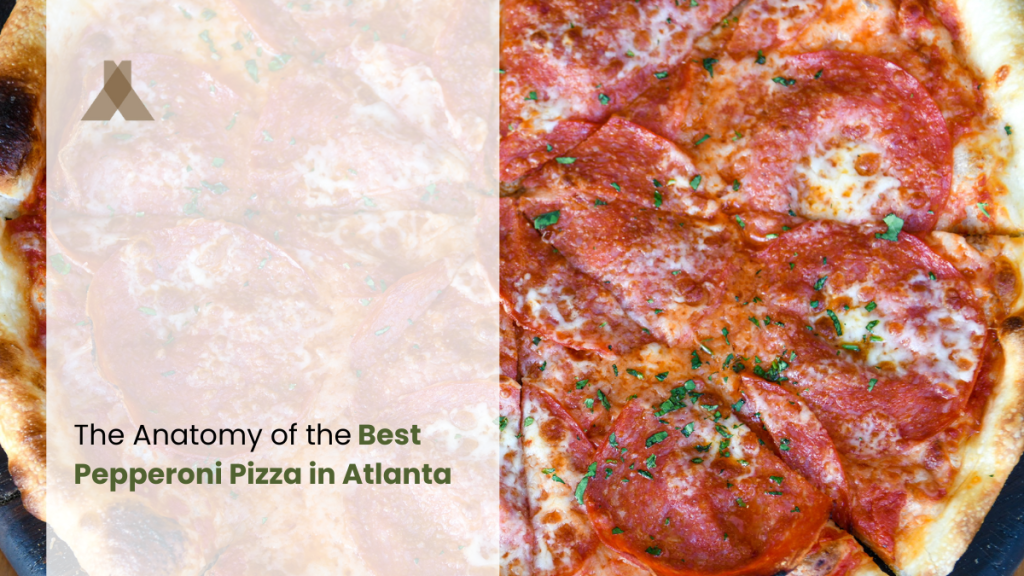All of us love a classic pepperoni pizza but, have you ever wondered what makes a pepperoni pizza really good?
Let’s analyze which are the elements of a great pepperoni pizza and define how to enjoy the best pepperoni pizza in Atlanta!

Elements of a Great Pepperoni Pizza
Crust
Clearly, the foundation of a good pizza is its crust, but each of the following styles has unique characteristics:
- Neapolitan-style: This crust is thin in the center with a puffy, charred edge (called the cornicione). It’s made with simple ingredients: flour, water, salt, and yeast. The dough is stretched by hand and cooked quickly (between 60 and 90 seconds) in a very hot wood-fired oven (around 900°F), which results in a chewy texture.
- New York-style: This crust is inspired by Neapolitan pizza but adapted to American ovens. So, it’s thin and crispy, yet pliable enough to fold (a classic New York eating method). The dough often includes oil and sugar, which helps achieve a crispier texture and more golden-brown color when baked at lower temperatures in a gas oven.
- Deep-dish: Popular in Chicago, this style features a thick crust formed into a deep pan. The crust is usually pre-baked before toppings are added, which creates a sturdy base for generous amounts of cheese, toppings, and sauce (which is typically on top in Chicago style).
Sauce
The sauce balances the pizza’s flavors. Traditional tomato sauce is usually made from San Marzano tomatoes, typically uncooked or lightly cooked to preserve the fresh tomato taste.
Garlic, basil, and red pepper flakes are common additions—Garlic adds depth, basil adds freshness, and red pepper flakes add a subtle heat.
Cheese
Without any doubt, mozzarella is the go-to cheese for pizza—Fresh mozzarella has a delicate flavor and melts into creamy pools. Low-moisture mozzarella (common on New York style pizzas) has a longer shelf life and melts more evenly. Smoked mozzarella imparts a subtle smoky flavor.
However, there are many variations that are also worthwhile trying:
- Provolone: Adds a sharp, slightly tangy flavor.
- Parmesan: Brings a salty, nutty taste and can be used sparingly as it’s quite strong.
- Burrata, a fresh Italian cheese made from mozzarella and cream, can be dolloped on after baking for a creamy texture.
Pepperoni
Pepperoni is a spiced salami made from cured pork and beef. Traditional pepperoni is mildly spicy with a slightly smoky flavor while the spicy pepperoni variety incorporates more red pepper flakes or other hot spices.
What Are the Features that Pepperoni Should Have to Be Great for a Good Pepperoni Pizza?
There are a few key features that make for high-quality pepperoni on a delicious pepperoni pizza. Take them into account:
- Spice and Flavor Profile:
- The pepperoni should have a robust, savory flavor with a mild to moderate spice level. Typical spices are paprika, garlic, black pepper, and a hint of chili pepper or cayenne.
- The right balance of spices creates a pepperoni that is flavorful without being overpowering.
- Texture and Crisping:
- Ideal pepperoni should have a slightly chewy, almost crunchy texture when cooked, and the edges of the pepperoni slices should curl up and crisp when baked (creating those signature “pepperoni cups”).
- Fat Content:
- Pepperoni with a moderate fat content (around 30%) is preferred for pizza—The fat renders during baking, which adds moisture and richness to the pepperoni.
- Too little fat can result in dry pepperoni, while too much fat can make it overly greasy.
- Casing:
- Natural casings (made from sheep or hog intestines) are preferred over artificial casings, since these allow the pepperoni to curl and crisp up better in the oven.
- Meat Quality:
- High-quality pepperoni is typically made with a blend of premium pork and beef, and the meat should be freshly ground and free of additives or fillers.
- This results in a more flavorful, tender pepperoni.
- Slicing Thickness:
- Thin slices of pepperoni (around 1/8 to 1/4 inch thick) work best for pizza—Thinner slices crisp up more easily in the oven and distribute the flavor more evenly across the pie, while thicker ones can become chewy or greasy if not cooked properly.
Additional Toppings
While pepperoni is delicious on its own, additional toppings can create new flavor profiles. For instance, vegetables like bell peppers add sweetness and crunch, onions provide sharpness, and mushrooms bring an earthy umami flavor. Italian sausage and bacon can be a good addition as well, as they provide more spiciness and a smoky element respectively.
Finishing Touches
These final additions can elevate a good pizza to great:
- Hot honey (honey infused with chili peppers) has become increasingly popular as it adds a sweet-spicy kick that complements fantastically the savory pepperoni.
- Fresh basil leaves added after baking provide a burst of herbal freshness.
- A final sprinkle of high-quality grated Parmigiano Reggiano adds a nutty, salty finish.
Cooking Method
The way a pizza is cooked significantly affects its final taste and texture—Wood-fired ovens, reaching temperatures of 800-1000°F, cook pizzas quickly, creating a perfectly crisp crust with subtle smoky notes. On the other hand, home cooks can approximate this with a pizza stone, which helps achieve a crispier crust by absorbing moisture from the dough.
Popular Variations of the Best Pepperoni Pizza in Atlanta
Pepperoni and Jalapeño
This combination adds a spicy kick to the classic pepperoni pizza. The heat from jalapeños complements the spicy flavor of the pepperoni. Some people prefer the sharp heat of fresh jalapeños; others enjoy the milder heat of pickled ones.
Meat Lovers’
This variation is only for serious carnivores! It features pepperoni alongside other meats such as Italian sausage, bacon, ham, and sometimes ground beef. The combination of different meats creates a very satisfying, protein-rich meal.
Veggie and Pepperoni
The most common vegetables used in this version are bell peppers, onions, mushrooms, and olives. These add freshness and different textures to the pizza.
Pepperoni and Mushroom
This is a fantastic combination that pairs the savory pepperoni with earthy mushrooms.
The umami flavor of mushrooms complements the pepperoni wonderfully, and various mushroom types can be used, from common button mushrooms to more exotic varieties like shiitake or porcini.
Pepperoni and Ricotta
This variation adds dollops of creamy ricotta cheese, which provides a pleasant contrast to the spicy, salty pepperoni.
Often, the ricotta is added in dollops after baking, creating pockets of cool, creamy cheese!
This combination can be found in New York-style pizzerias and offers a more gourmet take on pepperoni pizza.
BBQ Pepperoni
This version has BBQ sauce instead of (or alongside) traditional tomato sauce, which creates an interesting contrast with the spicy pepperoni.
Hawaiian-style with Pineapple
This is a controversial variation! But, although it’s divisive, it has its fans.
In this version, the sweetness of the pineapple contrasts with the salty pepperoni, and some people argue that the acidity of the pineapple helps cut through the richness of the cheese and meat.
What’s more, this version often includes ham as well, which helps create a “Hawaiian” flavor profile.
Relish the Best Pepperoni Pizza in Atlanta at Mission + Market!
So by now, you have a good understanding of what makes a great pepperoni pizza. It’s time to look for the best options and enjoy!
If you’d like to relish the best pepperoni pizza in Atlanta, visit us at Mission+Market!



